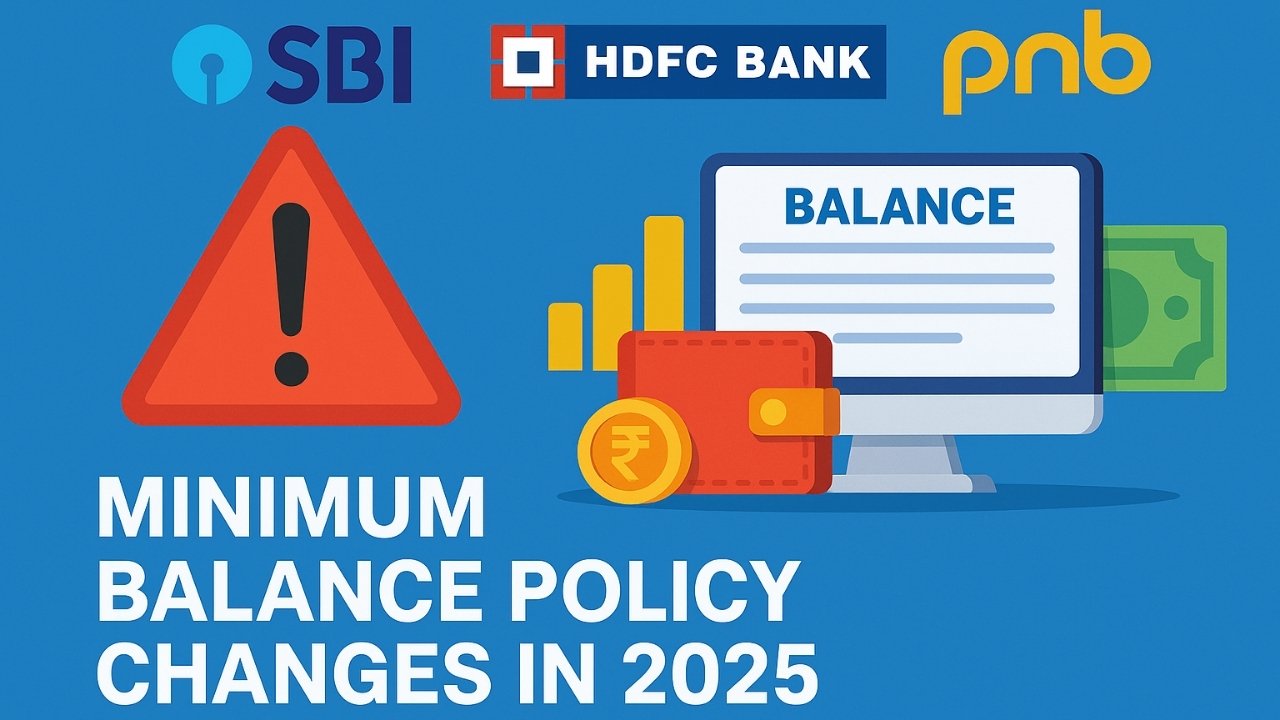Millions of customers banking with the State Bank of India, HDFC Bank, and Punjab National Bank (PNB) need to stay alert in 2025. All three major banks have revised their minimum balance requirements for savings accounts, and these changes are now in effect.
Understanding these changes is essential to avoid unwanted penalty charges and to manage accounts properly. These updates are not just about balance limits, they include new penalty structures, special provisions for certain categories, and better digital alerts.
An Overview of Policy Changes
The changes are part of a broader policy shift to align banking services with current financial needs. Banks have introduced location-based balance slabs, modernized penalty rules, and rolled out customer-friendly services to make compliance easier.
Location-Wise Balance Requirement
Each bank has now adopted different minimum balance limits based on whether the account is in a metro, urban, semi-urban, or rural area. Here’s a comparison of new requirements:
| Bank Name | Account Type | Metro | Urban | Semi-Urban | Rural |
|---|---|---|---|---|---|
| SBI | Regular Savings | ₹3,000 | ₹2,000 | ₹1,000 | ₹500 |
| Salary Account | ₹1,000 | ₹500 | ₹500 | ₹500 | |
| Student/Sr. Citizen | No Minimum | No Minimum | No Minimum | No Minimum | |
| HDFC | Regular Savings | ₹5,000 | ₹5,000 | ₹2,500 | ₹1,000 |
| Premium Savings | ₹10,000 | ₹10,000 | ₹5,000 | ₹2,500 | |
| Basic/Student | ₹1,000 / ₹500 | ₹500 | No Minimum | No Minimum | |
| PNB | Standard Savings | ₹2,000 | ₹1,000 | ₹500 | ₹250 |
| Premium Savings | ₹5,000 | ₹3,000 | ₹2,000 | ₹1,000 | |
| Basic Account | No Minimum | No Minimum | No Minimum | No Minimum |
Updated Penalty Charges for Non-Maintenance
Banks have also restructured the penalty charges for not maintaining the required balance. The new charges are linked to the amount shortfall and vary across banks.
SBI Penalty Slabs
| Shortfall | Metro/Urban Charge | Semi-Urban/Rural Charge |
|---|---|---|
| Up to 50% | ₹10 + GST | ₹7.50 + GST |
| 50–75% | ₹15 + GST | ₹10 + GST |
| Above 75% | ₹20 + GST | ₹12 + GST |
HDFC Penalty Slabs
| Shortfall Amount | Penalty (All Locations) |
|---|---|
| Up to ₹999 | ₹150 + GST |
| ₹1,000 – ₹4,999 | ₹300 + GST |
| ₹5,000 and above | ₹600 + GST |
PNB Penalty Per Quarter
| Account Type | Penalty Range |
|---|---|
| Standard Savings | ₹50 – ₹100 + GST |
| Premium Savings | ₹100 – ₹300 + GST |
Who Gets Exemptions? Special Categories Explained
Some account holders are exempt from these rules or have reduced obligations.
| Category | Special Provision |
|---|---|
| Senior Citizens | No minimum balance required |
| Students | Most banks offer zero-balance accounts |
| Government Benefit Users | Special accounts with relaxed norms |
| Low-Income Groups | Basic savings accounts are available |
How Different Customers Are Affected
Urban Account Holders
- Must maintain higher balances (up to ₹10,000 for premium accounts in HDFC).
- Benefit from better mobile banking features.
- Face higher penalties but also enjoy more financial tools.
Rural Account Holders
- Enjoy lower thresholds, starting as low as ₹250 in PNB.
- Lower penalties make accounts more accessible.
- Simple banking plans encourage inclusion.
How to Avoid Penalties?
Customers can follow these basic methods to avoid penalty deductions:
- Use Digital Alerts: Set up SMS/email alerts for low balance warnings. Use mobile apps to track daily balance.
- Automate Your Transactions
- Consider Account Type: Shift to Basic Savings Account if maintaining high balances is tough. Students and seniors should verify if their bank automatically applies exemptions.
- Close Unused Accounts
Key Suggestions from Financial Experts
Experts recommend a few strategies to adjust to the changes:
- Follow the 50/30/20 rule: Spend 50% on needs, 30% on wants, and save 20%.
- Create an emergency fund: Keep at least 3–6 months of expenses.
- Monitor bank policies: Stay updated on official communications.
- Review account features yearly: You might be eligible for a more suitable account type.
These changes by SBI, HDFC, and PNB are designed to modernize account management while encouraging responsible banking. While the new structure may seem strict, it also comes with improved tools and tailored accounts for special groups.
The best way forward is to review your current bank account, know your applicable minimum balance, and take advantage of digital banking for easy tracking. Always check directly with your bank for the most accurate and current updates.
If facing issues or unclear deductions, customers can contact their bank’s customer support or raise complaints through the RBI Complaint Management System.
